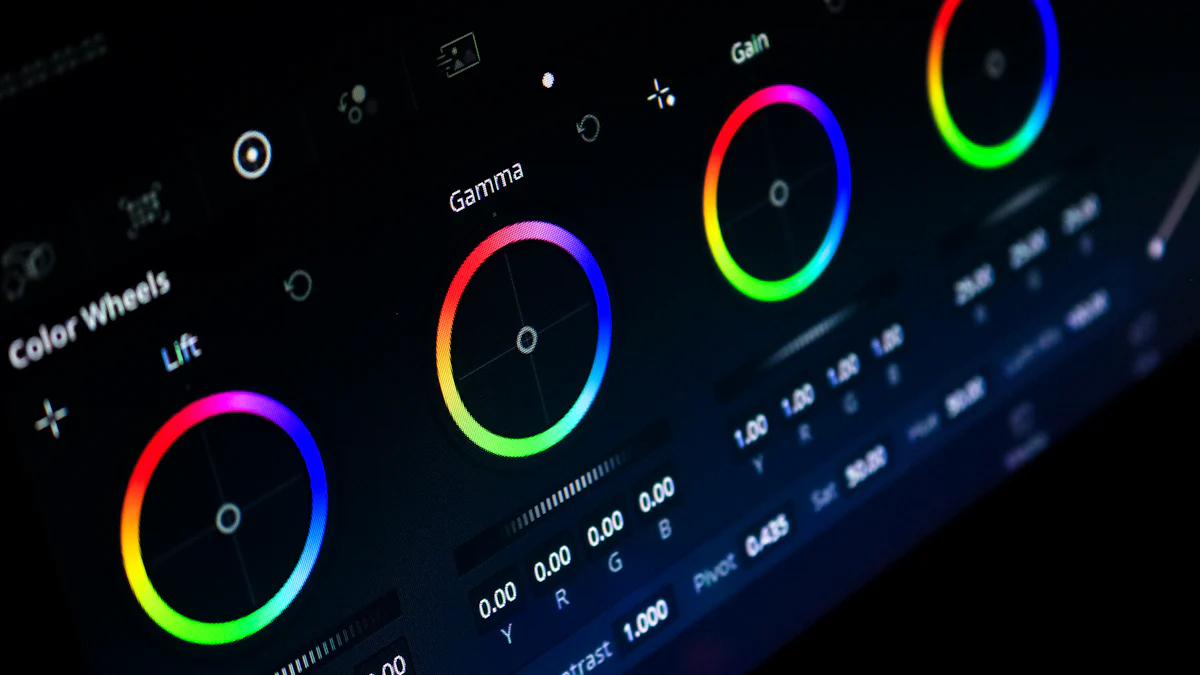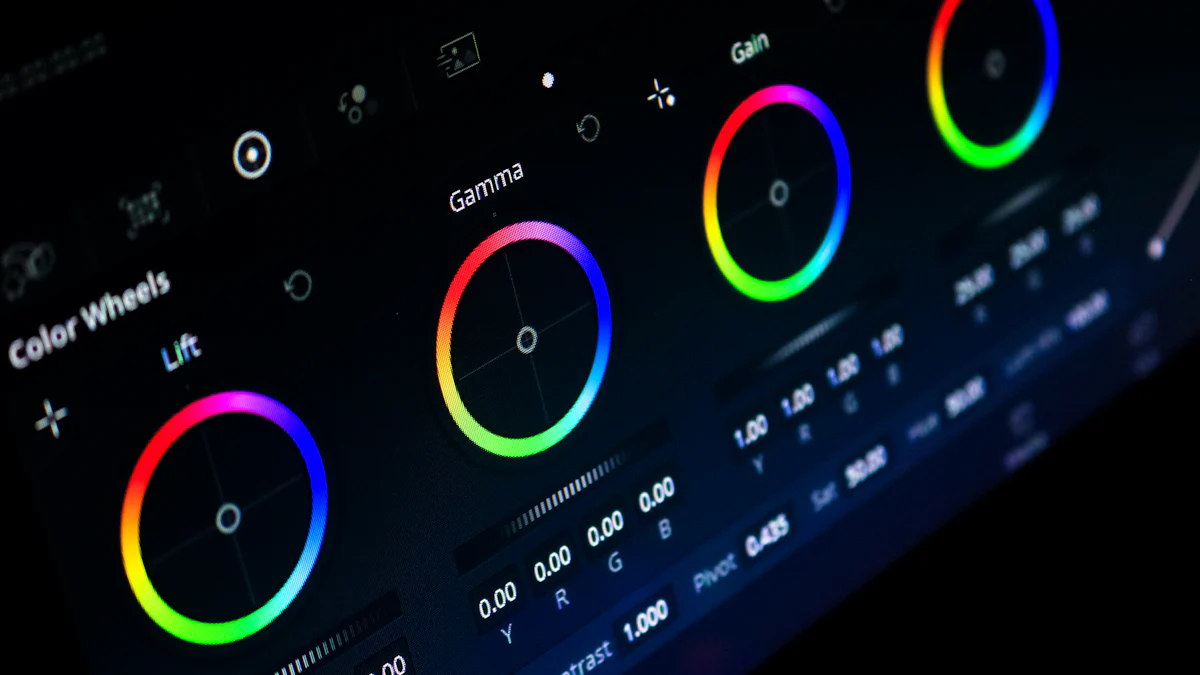Film Editing
Color Grading vs. Color Correction: Understanding the Difference
By
Alex Darke
July 23, 2024 10:54 pm
Color plays a pivotal role in visual media. The right hues can evoke emotions, set the tone, and enhance storytelling. However, many people confuse color grading vs color correction. These processes, while related, serve different purposes in video and photo editing. Understanding the distinction between color grading vs color correction is crucial for achieving the desired visual impact. This blog aims to clarify the differences and applications of each process, providing insights into how they contribute to the final look of a project.
Color Grading vs. Color Correction: Definitions and Basic Concepts

Image Source: unsplash
What is Color Correction?
Definition and Purpose
Color correction involves adjusting the colors in video or photo footage to achieve a natural and balanced look. The primary goal is to make the footage appear as the human eye would see it. This process corrects any color imbalances, ensuring that whites appear white and blacks appear black. Color correction compensates for inaccurate camera settings and varying lighting conditions.
Common Techniques
Several techniques are commonly used in color correction:
- White Balance Adjustment: Ensures that the colors in the footage are accurate by setting the correct color temperature.
- Exposure Correction: Adjusts the brightness levels to ensure that the footage is neither too dark nor too bright.
- Contrast Adjustment: Enhances the difference between the light and dark areas of the footage.
- Saturation Control: Regulates the intensity of colors to avoid overly vivid or dull footage.
Tools Used
Professionals use various tools for color correction:
- Adobe Premiere Pro: Offers comprehensive color correction features.
- DaVinci Resolve: Known for its advanced color correction capabilities.
- Final Cut Pro: Provides intuitive color correction tools.
What is Color Grading?
Definition and Purpose
Color grading is the process of enhancing the visual tone and mood of footage through creative adjustments. Unlike color correction, which aims for technical accuracy, color grading focuses on achieving a specific aesthetic. This process involves altering the color palette to evoke emotions and support the storytelling.
"Color grading involves adding filters and adjusting the shades of the footage to create a certain mood or aesthetic." - Various Experts
Common Techniques
Color grading employs several techniques to achieve the desired look:
- Color Filters: Apply filters to change the overall color tone of the footage.
- Hue Shifts: Adjust specific colors to create a unique visual style.
- LUTs (Look-Up Tables): Use pre-defined color grading presets to achieve consistent looks across different scenes.
- Selective Color Adjustments: Enhance or mute specific colors to draw attention to particular elements in the footage.
Tools Used
Color grading requires specialized tools:
- Adobe Premiere Pro: Includes advanced color grading features.
- DaVinci Resolve: Renowned for its professional-grade color grading capabilities.
- Final Cut Pro: Offers user-friendly color grading tools.
Color Grading vs. Color Correction: Detailed Explanations and Comparisons
Key Differences Between Color Grading and Color Correction
Objectives and Goals
Color correction aims to achieve a natural and balanced look in visual media. This process corrects color imbalances, exposure problems, and unwanted color casts. The goal is to ensure that the footage appears as the human eye would see it.
In contrast, color grading focuses on enhancing the visual tone and mood of the footage. This process involves altering colors to create a specific atmosphere or style. Color grading allows for creative interpretation, enhancing the narrative and emotive power of the footage.
Processes Involved
Color correction involves several technical steps:
- White Balance Adjustment: Ensures accurate color temperature.
- Exposure Correction: Adjusts brightness levels.
- Contrast Adjustment: Enhances light and dark areas.
- Saturation Control: Regulates color intensity.
Color grading employs artistic techniques:
- Color Filters: Change the overall color tone.
- Hue Shifts: Adjust specific colors.
- LUTs (Look-Up Tables): Apply pre-defined presets.
- Selective Color Adjustments: Enhance or mute specific colors.
When to Use Each
Use color correction when aiming for technical accuracy. This process ensures consistency and balance in the footage. Correcting problems like color imbalances and exposure issues is crucial.
Use color grading when aiming for a stylistic look. This process allows for creative expression. Altering colors to create a specific mood or atmosphere enhances the visual appeal.
How They Work Together
Workflow Integration
Color correction and color grading often work together in a seamless workflow. Start with color correction to establish a natural, consistent foundation. This step ensures that the footage is technically sound.
After achieving a balanced look, proceed to color grading. This step involves creative adjustments to enhance the visual tone and mood. Combining both processes ensures a polished and professional final product.
Case Studies and Examples
Consider a documentary film. The initial step involves color correction to address any color imbalances and exposure issues. This step ensures that the footage looks natural and consistent.
Next, apply color grading to enhance the storytelling. Use color filters and hue shifts to evoke specific emotions. For instance, use warm tones to convey a sense of nostalgia or cool tones to create a somber mood.
Another example is a commercial video. Start with color correction to achieve a balanced look. Then, use color grading to align the footage with the brand's aesthetic. Apply LUTs to maintain a consistent look across different scenes.
Practical Applications and Tips

Image Source: unsplash
Tips for Effective Color Correction
Best Practices
- White Balance Adjustment: Always start by setting the correct white balance. This step ensures that colors appear natural and consistent across all footage.
- Exposure Correction: Adjust brightness levels to avoid overexposed or underexposed footage. Proper exposure enhances detail visibility.
- Contrast Adjustment: Increase contrast to make the footage more dynamic. This adjustment helps in distinguishing between light and dark areas.
- Saturation Control: Regulate color intensity to avoid overly vivid or dull footage. Balanced saturation maintains a natural look.
Common Pitfalls to Avoid
- Overcorrection: Avoid making extreme adjustments. Overcorrection can lead to unnatural-looking footage.
- Ignoring White Balance: Failing to set the correct white balance can result in color casts. Always prioritize white balance adjustment.
- Inconsistent Corrections: Ensure uniform corrections across all scenes. Inconsistencies can disrupt the visual flow.
- Neglecting Shadows and Highlights: Pay attention to both shadows and highlights. Ignoring these elements can lead to loss of detail.
Tips for Effective Color Grading
Best Practices
- Use LUTs (Look-Up Tables): Apply LUTs to achieve consistent looks across different scenes. LUTs provide a quick way to implement complex color grades.
- Experiment with Color Filters: Use filters to change the overall color tone. Experimentation helps in finding the perfect mood for the footage.
- Selective Color Adjustments: Enhance or mute specific colors to draw attention to particular elements. This technique adds depth to the visual narrative.
- Maintain a Consistent Style: Stick to a consistent color grading style throughout the project. Consistency enhances the storytelling.
Common Pitfalls to Avoid
- Overuse of Filters: Avoid relying too heavily on filters. Overuse can make the footage look artificial.
- Ignoring the Original Footage: Always consider the original footage while grading. Ignoring it can lead to mismatched tones.
- Inconsistent Grading: Ensure consistent grading across all scenes. Inconsistencies can break the visual continuity.
- Neglecting Skin Tones: Pay special attention to skin tones. Incorrect adjustments can make skin look unnatural.
Recommended Tools and Resources
Software Recommendations
- DaVinci Resolve: Known for its professional-grade color correction and grading capabilities. The node-based system allows for precise adjustments.
- Adobe Premiere Pro: Offers robust color correction tools like Lumetri Color. Ideal for achieving balanced and visually stunning videos.
- Magic Bullet Colorista: Provides a user-friendly interface for quick and precise color adjustments. Suitable for both novices and professionals.
- Magic Bullet Looks: Comes with a variety of presets for one-click styling. Perfect for achieving a consistent look across different scenes.
- Fylm.ai: Offers comprehensive tools for both color correction and grading. A versatile option for video editors.
Learning Resources
- Online Tutorials: Platforms like YouTube and Coursera offer numerous tutorials on color grading vs color correction.
- Books and E-books: Consider reading books dedicated to color correction and grading techniques. These resources provide in-depth knowledge.
- Workshops and Courses: Enroll in workshops and courses offered by industry experts. Hands-on training enhances practical skills.
- Community Forums: Join forums and online communities. Engaging with other professionals provides valuable insights and tips.
The blog has covered the essential differences between color grading and color correction. Understanding both processes is crucial for achieving professional-quality visual media. Mastering these techniques will enable editors to meet client expectations effectively.
Experimentation and practice will enhance skills in both areas. Professionals should explore various tools and techniques to find what works best for their projects.
"One of the biggest requirements of a professional colorist is the ability to understand what the client is looking for and figure out how to best achieve it." - Adam
For further learning, consider exploring additional resources and tutorials.

About the Author
Alex Darke is an Emmy-winning filmmaker, founder of the production company Momentous and owner of Filmmaking Central.

Filmmaking Central is a cutting-edge e-learning company dedicated to empowering aspiring filmmakers and content creators worldwide. With a robust library of comprehensive courses, expert-led workshops, and interactive learning materials, Filmmaking Central provides students with unparalleled access to industry professionals and innovative tools. By fostering an online community of passionate learners and storytellers, the platform aims to inspire creativity, develop essential skills, and ultimately cultivate the next generation of visionary filmmakers.
CONTACT
📍Las Vegas, NV
☎️ +1 888 494 5107
📧 hello@filmmakingcentral.com
SOCIAL
A Momentous Company © Filmmaking Central, All Rights Reserved. Here's our cookie policy page with all sorts of fun stuff. You know, privacy policy, disclaimer, and terms kind of stuff. Go back to the homepage or check out our courses and subscribe to our YouTube channel. You can also see our anti-SPAM policy, DCMA notice, earnings disclaimer, and affiliate disclosure.
